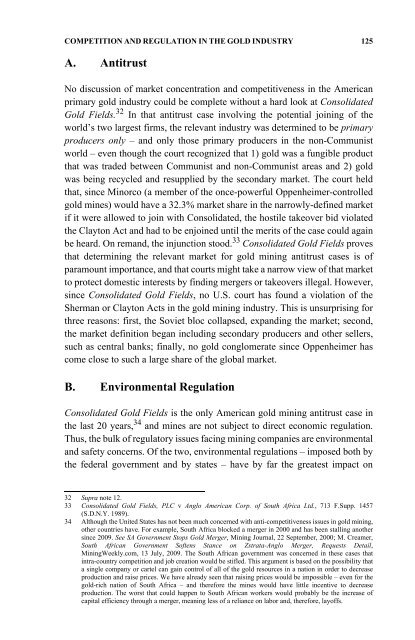University of Botswana Law Journal - PULP
University of Botswana Law Journal - PULP
University of Botswana Law Journal - PULP
You also want an ePaper? Increase the reach of your titles
YUMPU automatically turns print PDFs into web optimized ePapers that Google loves.
COMPETITION AND REGULATION IN THE GOLD INDUSTRY 125<br />
A. Antitrust<br />
No discussion <strong>of</strong> market concentration and competitiveness in the American<br />
primary gold industry could be complete without a hard look at Consolidated<br />
Gold Fields. 32 In that antitrust case involving the potential joining <strong>of</strong> the<br />
world’s two largest firms, the relevant industry was determined to be primary<br />
producers only – and only those primary producers in the non-Communist<br />
world – even though the court recognized that 1) gold was a fungible product<br />
that was traded between Communist and non-Communist areas and 2) gold<br />
was being recycled and resupplied by the secondary market. The court held<br />
that, since Minorco (a member <strong>of</strong> the once-powerful Oppenheimer-controlled<br />
gold mines) would have a 32.3% market share in the narrowly-defined market<br />
if it were allowed to join with Consolidated, the hostile takeover bid violated<br />
the Clayton Act and had to be enjoined until the merits <strong>of</strong> the case could again<br />
be heard. On remand, the injunction stood. 33 Consolidated Gold Fields proves<br />
that determining the relevant market for gold mining antitrust cases is <strong>of</strong><br />
paramount importance, and that courts might take a narrow view <strong>of</strong> that market<br />
to protect domestic interests by finding mergers or takeovers illegal. However,<br />
since Consolidated Gold Fields, no U.S. court has found a violation <strong>of</strong> the<br />
Sherman or Clayton Acts in the gold mining industry. This is unsurprising for<br />
three reasons: first, the Soviet bloc collapsed, expanding the market; second,<br />
the market definition began including secondary producers and other sellers,<br />
such as central banks; finally, no gold conglomerate since Oppenheimer has<br />
come close to such a large share <strong>of</strong> the global market.<br />
B. Environmental Regulation<br />
Consolidated Gold Fields is the only American gold mining antitrust case in<br />
the last 20 years, 34 and mines are not subject to direct economic regulation.<br />
Thus, the bulk <strong>of</strong> regulatory issues facing mining companies are environmental<br />
and safety concerns. Of the two, environmental regulations – imposed both by<br />
the federal government and by states – have by far the greatest impact on<br />
32 Supra note 12.<br />
33 Consolidated Gold Fields, PLC v Anglo American Corp. <strong>of</strong> South Africa Ltd., 713 F.Supp. 1457<br />
(S.D.N.Y. 1989).<br />
34 Although the United States has not been much concerned with anti-competitiveness issues in gold mining,<br />
other countries have. For example, South Africa blocked a merger in 2000 and has been stalling another<br />
since 2009. See SA Government Stops Gold Merger, Mining <strong>Journal</strong>, 22 September, 2000; M. Creamer,<br />
South African Government S<strong>of</strong>tens Stance on Zstrata-Anglo Merger, Requests Detail,<br />
MiningWeekly.com, 13 July, 2009. The South African government was concerned in these cases that<br />
intra-country competition and job creation would be stifled. This argument is based on the possibility that<br />
a single company or cartel can gain control <strong>of</strong> all <strong>of</strong> the gold resources in a nation in order to decrease<br />
production and raise prices. We have already seen that raising prices would be impossible – even for the<br />
gold-rich nation <strong>of</strong> South Africa – and therefore the mines would have little incentive to decrease<br />
production. The worst that could happen to South African workers would probably be the increase <strong>of</strong><br />
capital efficiency through a merger, meaning less <strong>of</strong> a reliance on labor and, therefore, lay<strong>of</strong>fs.
















